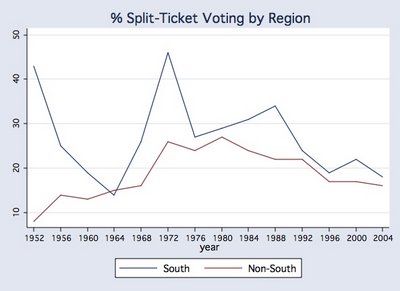This is just a guess, and maybe someone with access to the data can check this, but here's what I think happened: during the 60s, Southern whites started voting for Republican presidents while continuing to vote for local Democratic congressmen. After 1972, though, as the Republican shift of the South continued, they started voting for Republican congressmen too. In other words, I'll bet that the split-ticket phenomenon — both up and down — is almost entirely explained by the South, not by some massive nationwide shift toward independence.
I ran the numbers (they're in the chart below) and Kevin's partly right. Split-ticket voting has almost always been higher in the South (1964 is the exception). Nonetheless, both regions have seen a general decline in split-ticket voting over the last few decades.

The key point is that regardless of region, there's no evidence (contrary to what Mark Penn claims) of significant growth in split-ticket voting in recent elections.
1 comment:
I find all this stuff fascinating - though strictly as an amateur!
For instance, I note from your chart that split-ticket voting in the South (which I'm assuming you define as the Confederacy - if you're including border states, that may make a difference) declines between 1952 and 1956 by what looks to me to be around 15 points.
Whereas I'd have assumed that, since Ike did better in the Confederacy in 56 than in 52, the pattern would be the reverse.
The Senate stayed solid. My listing of House members from the Voteview boys suggests that, in the House, there was a rearranging of the deckchairs, comparing 56 and 52: in 52, the only GOP seats in the Confederacy were NC-10, TN-1 & 2, VA-6, 9 & 10; in 56, FL-1 and TX-5 were gained, VA-9 lost.
Whereas Ike's margin in the popular vote went from -315,000 to +110,000.
Just curious.
Post a Comment